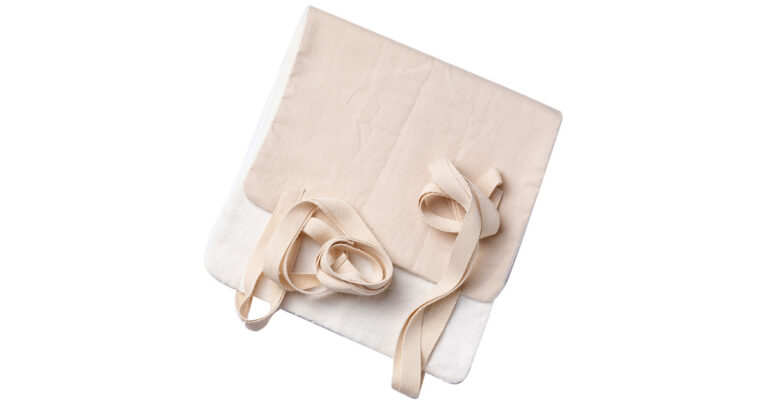Has pelvic pain been impacting your daily life?
Are you searching for natural remedies to address pelvic floor dysfunction, pelvic inflammatory disease, or pelvic adhesions?
The castor oil pelvic pack might be a solution you’ve heard about, and you’re likely wondering if it’s truly effective and how to use it properly.
This article delves into the world of castor oil packs for pelvic area concerns, exploring their potential benefits, how to use them, and answering common questions about using castor oil packs.
Understanding Castor Oil Packs
Castor oil pelvic packs involve applying a cloth saturated in organic pelvic castor oil pack kit to the lower abdomen and pelvic region.
The pack is then warmed using a hot water bottle or heating pad to promote better absorption.
This ancient practice has been used for centuries in various cultures as a holistic approach to supporting healing and wellbeing.
The idea is that the ricinoleic acid in castor oil, when applied topically, can help promote circulation and lymphatic drainage, potentially bringing relief from inflammation and discomfort the pelvic area.
Potential Benefits of Castor Oil Pelvic Packs
While research on castor oil pack for pelvic organ prolapse and other pelvic conditions is still emerging, anecdotal evidence and traditional practices suggest it may offer benefits like:
- Reduced inflammation and pain in the pelvic region.
- Improved lymphatic drainage, which can help remove toxins and support a healthy immune system.
- Increased circulation to the pelvic organs.
- Potential relief from pelvic inflammatory disease symptoms.
- Relief from discomfort associated with pelvic adhesions.
- May offer support for those experiencing pelvic organ prolapse.
How to Use a Castor Oil Pelvic Pack
Ready to give it a try?
Here’s a simple step-by-step guide on how to effectively apply a castor oil pack pelvis:
- Gather your materials: You’ll need a piece of flannel or cotton cloth (ideally organic), organic pelvic castor oil pack kit, a hot water bottle or heating pad, and a plastic wrap or towel.
- Prepare the cloth: Fold the flannel cloth to the desired size to cover your lower abdomen and pelvis. Saturate the cloth with castor oil but avoid making it overly soaked.
- Apply the pack: Lie down comfortably and place the oiled cloth over the pelvic region.
- Apply heat: Place a hot water bottle or heating pad over the cloth. Make sure the temperature is comfortable and not too hot to avoid skin irritation.
- Relax and enjoy: Keep the pack in place for at least 30 minutes to an hour. Some people choose to apply a castor oil pack for longer, even overnight, especially if their goal is to address a specific condition, such as a castor oil pack for pelvic adhesions.
- Clean up: After removing the pack, gently clean the area with warm water and a mild soap. You can consider using a gentle organic body oil to moisturize the skin.
Precautions and Considerations
While castor oil packs for pelvic inflammatory disease or other conditions can offer potential benefits, it’s important to be cautious.
Here are some things to keep in mind:
- Skin sensitivity: If you have particularly sensitive skin, conduct a patch test on a small area before using a castor oil pack for pelvic area to see how your skin reacts. Some people do have sensitivities to castor oil.
- Pregnancy and breastfeeding: Consult with your healthcare provider before using castor oil packs if you are pregnant or breastfeeding. Research suggests that castor oil can stimulate uterine contractions and may not be recommended during pregnancy.
- Medical conditions: If you have any underlying medical conditions, it’s wise to discuss using castor oil packs for pelvic organ prolapse, or any other condition you may have with your healthcare provider before integrating castor oil pelvic packs into your routine.
- Allergies: If you are allergic to castor beans or castor oil, avoid using castor oil packs.
Castor Oil Pelvic Pack and Pelvic Conditions
Many people experience relief from pelvic conditions like castor oil pack pelvic floor dysfunction with this simple remedy, but it’s worth discussing this with your healthcare provider.
If you’re experiencing pelvic pain or issues, it’s always a good idea to see a doctor to get a diagnosis and discuss the best course of action.
Here’s a closer look at how castor oil pelvic pack may be relevant to certain conditions:
Castor Oil Pack for Pelvic Inflammatory Disease
Castor oil packs for pelvic inflammatory disease may provide some relief from symptoms like pain and inflammation due to potential anti-inflammatory properties.
However, it’s crucial to seek medical attention if you suspect you have PID, as it’s a serious infection that requires appropriate treatment.
Castor Oil Pack for Pelvic Adhesions
Castor oil pack for pelvic adhesions may potentially help reduce inflammation and improve circulation, which could contribute to the breakdown of scar tissue related to adhesions.
It’s important to note that using castor oil packs for this condition should be done alongside medical advice and under the care of your physician.
Castor Oil Pack and Pelvic Floor Dysfunction
Castor oil pack pelvic floor dysfunction is often explored by those experiencing pelvic pain, discomfort during intimacy, or issues with bladder or bowel control.
The potential benefits of increased circulation and relaxation in the pelvic area may provide comfort for individuals with these challenges.
Castor Oil Pack for Pelvic Organ Prolapse
For those with castor oil packs for pelvic organ prolapse, the idea behind applying a castor oil pack is that potentially increased circulation and tissue regeneration could be beneficial.
This method may be of support for some individuals, although it isn’t a primary treatment for prolapse.
It is important to consult with your doctor or physical therapist about proper treatment options.
Frequently Asked Questions
Let’s tackle some of the most frequently asked questions about using castor oil pelvic packs:
How long does it take to see results from a castor oil pack?
The time it takes to notice results can vary from person to person and depends on the specific condition being addressed.
Some individuals report feeling relief after a few applications, while others may need several weeks of consistent use.
The key is to be consistent with your routine and to listen to your body, giving castor oil pelvic packs time to work their magic.
Is it safe to use castor oil packs every day?
While some people use castor oil packs daily, it’s generally recommended that you start with a few times a week and see how your body responds.
If you experience any discomfort like skin irritation, it’s best to take a break and re-evaluate.
Can I use castor oil packs on my period?
It’s generally not recommended to use castor oil pelvic packs during your menstrual period, as the oil can interfere with the natural flow.
If you have any questions about this or other specific concerns, it’s always a good idea to check with your doctor.
Are castor oil packs right for me?
Whether castor oil packs are the right choice for you depends on your individual circumstances and health condition.
If you are interested in exploring rubbing castor oil on pelvis as a potential way to support your wellbeing, it’s a good idea to consult with your doctor or a holistic healthcare professional before trying castor oil pelvic packs, particularly if you have any pre-existing conditions.
Ultimately, a castor oil pelvic pack, when used responsibly and in conjunction with professional medical care, may offer a path toward soothing and healing.
If you are considering incorporating a castor oil pelvic pack into your wellness routine, consider taking a slow, deliberate approach, recognizing that results may vary from person to person.
Remember that a castor oil pelvic pack should never be used as a standalone treatment for any serious medical condition.
Always consult with a healthcare practitioner before incorporating any new treatment, especially when dealing with pelvic health concerns.



